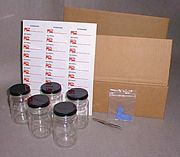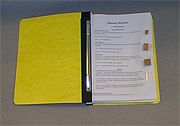Materials such as wood, plywood, paint, foam and fabric can emit harmful vapors into a case environment, subjecting the objects to damage. Acid migration from wood is especially harmful to textiles and paper, causing yellowing and embrittlement. Corrosive volatiles, released by certain glues, paints, fabrics and urea formaldehyde in plywood, cause metals to corrode.
Some materials currently considered safe for mounting and display: (This list does not constitute an endorsement from NSCC. Work with a conservator to determine whether materials are appropriate for your collection.)
- glass
- ceramics
- metals: within an approved tubing, or coated with approved coating
- woods: coated with an approved coating, overlay or laminate
- acid-free paper and cardboard
-
Fabrics:
- well washed and rinsed unbleached, undyed cotton, linen, polyester, polyacrylonitrile (Orlon) fabric
- (the above, dyed: if properly tested for colorfastness )
- polyester spun-bonded fabric (Reemay, Decron, Polartec, Terylene)
- Goretex
- Polyester quilt batting (heat fused, needle punched not resin cured)
- Velcro (not in direct contact), Expoloop
- polyethylene foam products (Ethafoam, Microfoam, Nalgene) (be aware of static electricity and the considerable force it can exert)
- polystyrene foam (Styrofoam), preferably extruded (no beads) (not in direct contact) (be aware of static electricity and the considerable force it can exert)
- Acid-free Fome-Cor, Artcor boards
- polyethylene plastic sheet (be aware of static electricity and the considerable force it can exert)
- polyethylene/air sheeting (Bubblepack, AirCap, Polycap) (be aware of static electricity and the considerable force it can exert)
- polyethylene tubing
- polyester sheeting (Mylar)
- nylon sheeting (Dartek) (nylon is less stable than the other plastics listed here, do not have in contact with artifacts)
- nylon monofilament (must be well padded in appropriate tubing)
- polypropylene corrugated boards (Coroplast or Cor-X)
- polymethylmethacrylate plastic (Plexiglas)
- polycarbonate plastic (Lexan)
- cotton embroidery floss (test for color fastness)
-
Adhesives:
- acrylic solutions (Acryloid)
- acrylic emulsions (Rhoplex)
- PVA emulsions (some exceptions)
- clear hot-melt adhesives (mostly PVA and wax)
|
MS204: Materials for Storage and Display Course Description & Info Instructor: Gretchen Anderson Student Login Price: $495 Nov 4 – Nov 29, 2013 [Learn More] Sep 1 – Sep 26, 2014 [Learn More]
|
Books and products we recommend:
 Materials Testing Kit Acid fumes are a danger to any collection. This kit provides information and supplies to aid in the testing of construction materials. The Materials Testing Kit includes 24 glass jars, acid detection strips, tweezers, silver coupons, lead coupons, aluminum foil, 1 sheet of preprinted labels and an instruction manual.
Materials Testing Kit Acid fumes are a danger to any collection. This kit provides information and supplies to aid in the testing of construction materials. The Materials Testing Kit includes 24 glass jars, acid detection strips, tweezers, silver coupons, lead coupons, aluminum foil, 1 sheet of preprinted labels and an instruction manual.
| Materials Testing Kit | $120.00 | |
|
Polished lead coupons (24) | $22.15 | |
|
Polished silver coupons (24) | $24.95 | |
| Materials Testing Kit Booklet | $15.00 |
 Museum Materials sample booklet Ordering archival supplies can be difficult and confusing. This booklet provides sample materials of the most common supplies currently offered and discusses how they are used in museums. Organized by function, the booklet covers rigid materials, padding materials, ties and attachments, barrier materials and "bad" materials.
Museum Materials sample booklet Ordering archival supplies can be difficult and confusing. This booklet provides sample materials of the most common supplies currently offered and discusses how they are used in museums. Organized by function, the booklet covers rigid materials, padding materials, ties and attachments, barrier materials and "bad" materials.
| Museum Materials sample booklet | $45.00 |
 CCI Tech Bulletin #14 Working with Polyethylene Foam and Fluted Plastic Sheet by Carl Schlichting
CCI Tech Bulletin #14 Working with Polyethylene Foam and Fluted Plastic Sheet by Carl Schlichting
Examines several techniques and illustrates a series of basic approaches that have been developed for working with polyethylene foam and fluted plastic. The many detailed illustrations clarify for the reader the fabrication methods described in the text.
| Working with Polyethylene Foam & Fluted Plastic | $18.00 |
NSCC Museum Materials Training Workshop
Links to related information on other sites:
REPAINT, REPAINT AND THIN NO MORE! or Classification of coatings and Summary of coating recommendations.
http://iaq.dk/papers/repaint.htm
DISPLAY MATERIALS: THE GOOD, THE BAD AND THE UGLY
http://iaq.dk/papers/good-bad-ugly.htm
